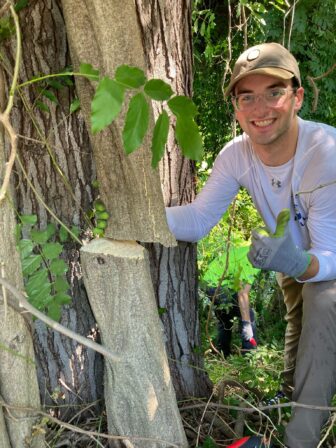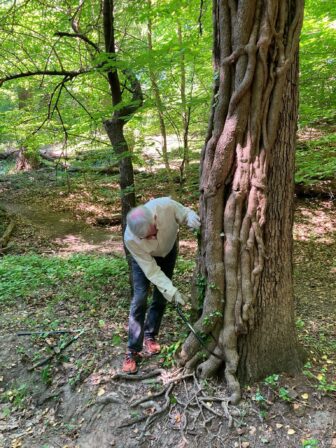Here’s how to remove invasive vines from trees. (It’s pretty easy!)
There are many invasive vines species in the Washington, DC area, as well as easily-confused native (and beneficial) vines. For that reason, CCAN suggests focusing on the ones that are most common, most threatening to our trees, and easiest to identify – English ivy, and to a lesser extent, wintercreeper. After you hone your skills, you can move on to more advanced vine cutting!
Also, please remember to always get permission to cut vines from property owners. In order to remove invasive plants from Montgomery Parks property, you must be a certified Weed Warrior. Learn more here. Getting certified as a Weed Warrior is also a great way to learn how to identify invasives.
Please review these ID tips for target plants, and ones to avoid cutting:
- DO CUT: English Ivy. See photos here
- DO CUT: Wintercreeper. See photos here
- DO CUT: Porcelainberry. See photos here and here. (see here and more below for comparison with native grape)
- English ivy vs. Poison ivy: While the leaves are quite different, the two vines can be difficult to distinguish if no leaves are present. Poison ivy can be identified by its finer, reddish-brown hairs. If you see poison ivy growing with English ivy, use caution and be careful not to touch the poison ivy. If the two vines are too tightly entwined, leave them alone. Poison ivy is a beneficial native vine that should not be cut unless it is found in a problematic location (e.g., playground, etc). See photos here, here, and here.
- DO NOT CUT: Virginia creeper, another beneficial native vine, and less annoying than poison ivy.
- DO NOT CUT: Native grape, which is easily confused with porcelainberry, a nasty invasive. See more here and here and here.
- DO NOT CUT: Greenbrier, another beneficial native, but with nasty thorns. See more here.
Lastly, if you don’t know what the vine is, don’t cut it!
Cutting invasive vines is a super simple process and it’s easy to get started. See below the 3 steps for removing invasive ivy and wintercreeper from trees. Also, watch this simple video!
3 Steps to Remove English Ivy (or Wintercreeper) from Trees
- Use garden clippers to cut ivy at head/shoulder height AND at the bottom around the entire trunk of all infested trees. This is called a “window” treatment – you will be clearing a “window” of ivy around the tree. The goal is to separate all ivy vines from their source of nutrients in the soil so they will die. If the ivy is not dense, you can pull it from the soil at the bottom of the tree with your hands, especially the day after it rains. On heavily infested trees with ivy vines thicker than an inch, you will need to carefully saw through the vine and carefully, gently ease it away from the tree’s bark (but be careful not to saw into the bark). Experiment with a pruner or pruning saw to find what works best for you. TIP: Wear gloves and long sleeves to lessen the risk of poison ivy. Many prefer doing this during the winter months when poison ivy is less virulent, and heavier clothing will reduce the risk of contact.
- Pull all ivy vines out of the ground around the base of the tree, making a 2 feet “life saver ring” around the tree. This will protect the tree from future infestations. This is easiest to do when the soil is soft from rains; if the ground is very hard and the vines keep breaking, wait until after a rain to remove the vines. The cleared space allows you to see any emerging ivy from roots you missed. Arborists suggest laying a 2″ thick leaf or wood chip mulch for three feet around the tree to preserve moisture in the soil and keep lawn mowers from getting too close to the roots. Keep the mulch 3″ away from the tree trunk to ensure air exchange for the bark, and you can spot any ivy trying to reinfest the tree.
- Once cut, you may carefully remove ivy from the window area. If it does not easily come off, leave ivy on the tree. Trying to pull a vine off the tree if it is deeply rooted in the bark could harm the tree. Also, never pull ivy down from the tree, as you could harm the tree by removing branches, and/or injure yourself. Don’t worry if you aren’t able to remove all ivy from the window. Ivy will gradually blend into the tree bark after it is cut. Just make sure that the ivy is cleanly cut.





